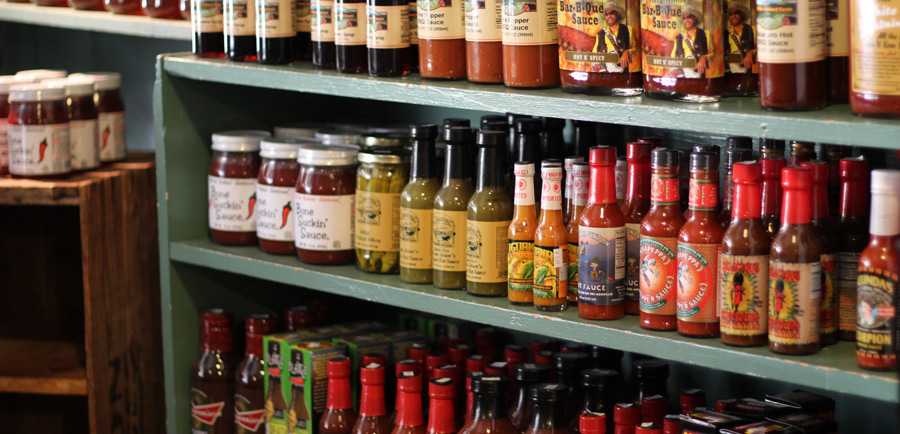
UPDATE: You can now order our BBQ Sauce Online! Click Here!
The Switzerland General Store now carries a HUGE selection of hot Sauces. Yes, we are riding the wave of popularity made famous by Sriracha and Tabasco because we LOVE the flavor explosion they offer. Generally, the varieties of peppers that are used most often in hot sauces are cayenne, chipotle, habanero and jalapeño. But there is so much more out there! Serranos, Poblanos, The Caribbean and Thai influences as well as Indian spices .
Evidence of hot sauces have been found in all kinds of ancient ruins, and ships. Hot Sauce has been important in making food more palatable as well as being medicinal, aiding in digestion and is great for the liver. It is also believed that it releases endorphins with that surge of HOT when you eat chilies. Some hot sauces, notably Tabasco sauce, are aged in wooden casks similar to the preparation of wine and fermented vinegar. Yes, hot sauces can be fermented. Fermentation not only adds a complexity to the taste, but also can be make your sauce more palatable for some folks.
As far as what’s available in our store, let’s start with those that have no heat at all. “Smoky Mountain Hot Sauce” from Hillside Orchard Farms in Ga. The label includes goofy images of hillbillies and banjos. You know the style. We like it because it has a smoky yet fruit sweet flavor with no heat. Not overly sweet at all. It works as a flavoring for those that are fearful of too much heat. It’s actually a lot of fun to try with beef or pork or just as a substitute wherever you would normally use hot sauce.
Next we offer something called “Cow Pie Hot Sauce” from Hillside Orchards again. We found this one at the Asheville Farmers Market and really love it. Very Mild, no heat. It reminds us of a Remoulade sauce and can be used as a handy enhancement to any appetizer or main dish.
A big seller for us is the Georgia Peach and Vidalia Onion Hot Sauce. Considered mild to medium heat. It’s a little Sweet so it would be great on a broiled salmon or tuna. Another quick and easy meal enhancement that’s just handy to have around.
”Iguana Deuces” brand from Half Moon Bay Trading Company. The label says it’s a “Golden Habanero Pepper Sauce”. On a heat scale from 1 to 10 we give it a 6. Medium-hot, made with veggies and “exotic spices”. We liked that it seemed to have layers of flavor. Good with fish or chicken, or just with steamed veggies.
“Blair’s Jalapeño Death” from Extreme Foods of NY is a green hot sauce that scores a 7 out of 10 in heat. We found it to be one of the freshest sauces we’ve tasted with a good flavor and a versatility that can lend itself to any South American inspired dish.
“Hotter than Hot” is a locally made sauce that scores an 8 out of 10 on the heat scale. One can taste flavors of chilies and even a hint of fruit. Great on wings or BBQ, it’s richness should make even the most seasoned hot sauce lover happy.
A nifty new product from Belize is called “Marie Sharp’s Beware”. It scores a 9 out of 10 on the heat scale. It offers a strong flavor of vinegar, lime and chilies.
Finally, the hottest sauce we found that we liked is “Neal’s Delicious Suffering” from a company called Sauce Crafters in Fl. An interesting blend of dried, toasted chilies, it scored a 9.5 out of 10 on our heat scale. We found hotter sauces, but none with this kind of complex flavor.
It’s common for some sauces to simply provide heat, with no real addition of flavor. Steer away from these. Hot sauce can be a delightful addition to your kitchen if you are brave enough to wade through the hype to arrive at some real flavor.
